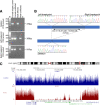A 127 kb truncating deletion of PGRMC1 is a novel cause of X-linked isolated paediatric cataract
- PMID: 33867527
- PMCID: PMC8385038
- DOI: 10.1038/s41431-021-00889-8
A 127 kb truncating deletion of PGRMC1 is a novel cause of X-linked isolated paediatric cataract
Abstract
Inherited paediatric cataract is a rare Mendelian disease that results in visual impairment or blindness due to a clouding of the eye's crystalline lens. Here we report an Australian family with isolated paediatric cataract, which we had previously mapped to Xq24. Linkage at Xq24-25 (LOD = 2.53) was confirmed, and the region refined with a denser marker map. In addition, two autosomal regions with suggestive evidence of linkage were observed. A segregating 127 kb deletion (chrX:g.118373226_118500408del) in the Xq24-25 linkage region was identified from whole-genome sequencing data. This deletion completely removed a commonly deleted long non-coding RNA gene LOC101928336 and truncated the protein coding progesterone receptor membrane component 1 (PGRMC1) gene following exon 1. A literature search revealed a report of two unrelated males with non-syndromic intellectual disability, as well as congenital cataract, who had contiguous gene deletions that accounted for their intellectual disability but also disrupted the PGRMC1 gene. A morpholino-induced pgrmc1 knockdown in a zebrafish model produced significant cataract formation, supporting a role for PGRMC1 in lens development and cataract formation. We hypothesise that the loss of PGRMC1 causes cataract through disrupted PGRMC1-CYP51A1 protein-protein interactions and altered cholesterol biosynthesis. The cause of paediatric cataract in this family is the truncating deletion of PGRMC1, which we report as a novel cataract gene.
© 2021. The Author(s).
Conflict of interest statement
The authors declare no competing interests.
Figures




Similar articles
-
Progesterone receptor membrane component-1 (PGRMC1) is the mediator of progesterone's antiapoptotic action in spontaneously immortalized granulosa cells as revealed by PGRMC1 small interfering ribonucleic acid treatment and functional analysis of PGRMC1 mutations.Endocrinology. 2008 Feb;149(2):534-43. doi: 10.1210/en.2007-1050. Epub 2007 Nov 8. Endocrinology. 2008. PMID: 17991724 Free PMC article.
-
Progesterone receptor membrane component 1 (PGRMC1) binds and stabilizes cytochromes P450 through a heme-independent mechanism.J Biol Chem. 2021 Nov;297(5):101316. doi: 10.1016/j.jbc.2021.101316. Epub 2021 Oct 20. J Biol Chem. 2021. PMID: 34678314 Free PMC article.
-
Spectroscopic and mutagenesis studies of human PGRMC1.Biochemistry. 2015 Mar 3;54(8):1638-47. doi: 10.1021/bi501177e. Epub 2015 Feb 23. Biochemistry. 2015. PMID: 25675345 Free PMC article.
-
Thoughts on interactions between PGRMC1 and diverse attested and potential hydrophobic ligands.J Steroid Biochem Mol Biol. 2017 Jul;171:11-33. doi: 10.1016/j.jsbmb.2016.12.020. Epub 2017 Jan 16. J Steroid Biochem Mol Biol. 2017. PMID: 28104494 Review.
-
PGRMC1 (progesterone receptor membrane component 1): a targetable protein with multiple functions in steroid signaling, P450 activation and drug binding.Pharmacol Ther. 2009 Jan;121(1):14-9. doi: 10.1016/j.pharmthera.2008.09.006. Epub 2008 Nov 1. Pharmacol Ther. 2009. PMID: 18992768 Free PMC article. Review.
Cited by
-
Pleiotropy of Progesterone Receptor Membrane Component 1 in Modulation of Cytochrome P450 Activity.J Xenobiot. 2024 May 1;14(2):575-603. doi: 10.3390/jox14020034. J Xenobiot. 2024. PMID: 38804287 Free PMC article. Review.
-
PGRMC1: An enigmatic heme-binding protein.Pharmacol Ther. 2023 Jan;241:108326. doi: 10.1016/j.pharmthera.2022.108326. Epub 2022 Dec 1. Pharmacol Ther. 2023. PMID: 36463977 Free PMC article. Review.
-
CYP51A1 in health and disease: from sterol metabolism to regulated cell death.Cell Death Discov. 2025 Jul 14;11(1):322. doi: 10.1038/s41420-025-02621-7. Cell Death Discov. 2025. PMID: 40659633 Free PMC article. Review.
-
A Systems Biology Approach for Investigating Significant Biomarkers and Drug Targets Common Among Patients with Gonorrhea, Chlamydia, and Prostate Cancer: A Pilot Study.Bioinform Biol Insights. 2023 Nov 27;17:11779322231214445. doi: 10.1177/11779322231214445. eCollection 2023. Bioinform Biol Insights. 2023. PMID: 38033384 Free PMC article.
-
Zebrafish Model in Ophthalmology to Study Disease Mechanism and Drug Discovery.Pharmaceuticals (Basel). 2021 Jul 25;14(8):716. doi: 10.3390/ph14080716. Pharmaceuticals (Basel). 2021. PMID: 34451814 Free PMC article. Review.
References
-
- Merin S, Crawford JS. The etiology of congenital cataracts. A survey of 386 cases. Can J Ophthalmol. 1971;6:178–82. - PubMed
Publication types
MeSH terms
Substances
LinkOut - more resources
Full Text Sources
Other Literature Sources
Medical
Molecular Biology Databases
Research Materials

